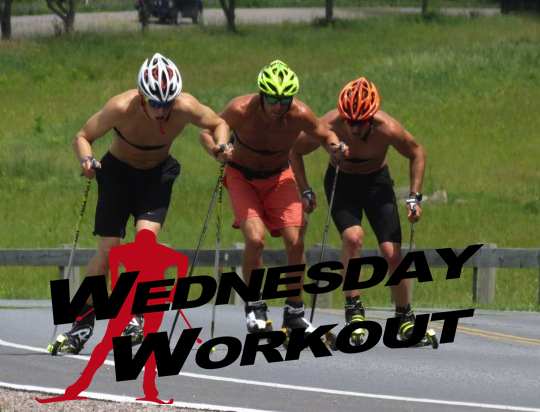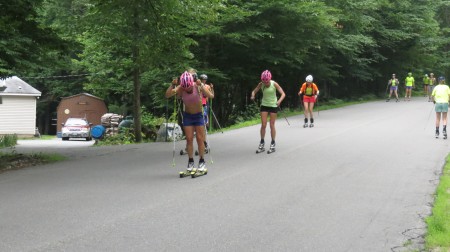
Welcome to Wednesday Workout, where we round up training ideas on a weekly basis. This week, Gus Kaeding, head coach of the Stratton Mountain School (SMS) T2 Team provides some ideas for coaches and athletes looking to spice up their training plan and see improvement in multiple areas.
***
Many skiers and coaches associate speeds with sprinting. That’s true, to an extent, but I believe this workout has additional benefits. With the rapid change in pace, a skier can learn technique, tactics and acquire neuromuscular adaptations, which help with distance skiing. Since there is often a lot of skiing back and forth, it is an easy workout for a coach to watch and have continued dialogue with the athletes.
After a full summer and fall of doing speeds regularly, athletes learn to ride their ski in a more forward position, even at a lower intensity. Additionally, they find it easier to go faster for a longer duration, because they are able to use their skeletal structures efficiently and not “muscle” each movement.
The actual structure of the workout can vary, depending on the time of the year and the goal of the workout. Generally, the Stratton Mountain School T2 elite athletes will do 15-24 speeds in a single session, ranging from 10 to 15 seconds each. At the beginning of the summer we will do fewer, shorter speeds, once a week. As the preparatory period goes on, we add in more speeds and the duration becomes longer (up to 40 seconds per speed). We’ll do these almost religiously throughout the preparatory period, up to twice a week at times during the late summer/fall.
Speed workouts can be set up a couple of different ways. One is stations, where we’ll do 5-8 speeds in one area, take a break (5-10 minutes of easy skiing), then rotate to another station and repeat. Full recovery between each individual speed is important.

When coordinating stations, we like to have one that practices starts, set up to mimic World Cup qualifiers and heats. Another station will have terrain requiring a technique transition, whether it be from V2 to V1 or striding to double pole. The final station usually involves a drop-in from a downhill to a flat. The flat mimics a finish.
By coming off a downhill, skiers are forced to either double pole or V2 at a higher speed than they are used to (overspeed). These will help athletes become more comfortable and efficient at higher speeds.
Another workout format is “rolling” speeds. For these, the athlete skis a 3-5 kilometer repeatable loop with three designated speed zones. Skiers never completely stop between speeds, giving the workout a continuous distance benefit.
Using the rolling format, the course is constantly changing. We try to find terrain features that are semi-unique to that trail or road. That way, the workout stays fresh and the athlete is ready for whatever race courses around the world may throw at them.
When our athletes ski the same terrain feature several times, they are encouraged to approach it in a variety of ways. Correct technique is always emphasized, even if it means backing off to a lesser exertion.
Often we’ll start speed workouts with the athletes skiing alone, so they can concentrate on technique. As they become comfortable, they will group up. Group speeds help with tactics and becoming comfortable skiing at high speed in a group. It also allows them to be pushed by an external force.



